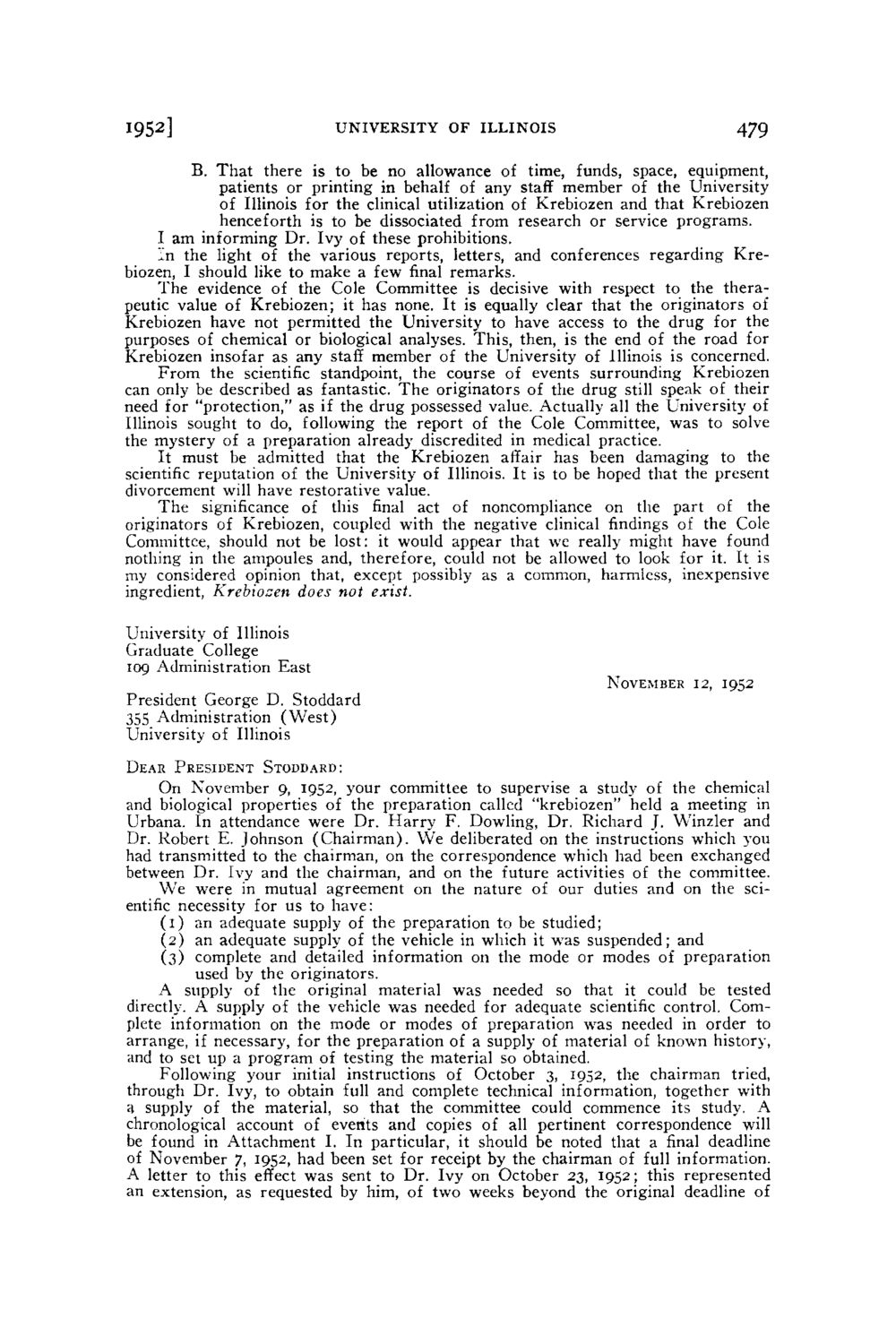| |
| |
Caption: Board of Trustees Minutes - 1954
This is a reduced-resolution page image for fast online browsing.

EXTRACTED TEXT FROM PAGE:
1952] U N I V E R S I T Y OF ILLINOIS 479 B. That there is to be no allowance of time, funds, space, equipment, patients or printing in behalf of any staff member of the University of Illinois for the clinical utilization of Krebiozen and that Krebiozen henceforth is to be dissociated from research or service programs. I am informing Dr. Ivy of these prohibitions. In the light of the various reports, letters, and conferences regarding Krebiozen, I should like to make a few final remarks. The evidence of the Cole Committee is decisive with respect to the therapeutic value of Krebiozen; it has none. It is equally clear that the originators of Krebiozen have not permitted the University to have access to the drug for the purposes of chemical or biological analyses. This, then, is the end of the road for Krebiozen insofar as any staff member of the University of Illinois is concerned. From the scientific standpoint, the course of events surrounding Krebiozen can only be described as fantastic. The originators of the drug still speak of their need for "protection," as if the drug possessed value. Actually all the University of Illinois sought to do, following the report of the Cole Committee, was to solve the mystery of a preparation already discredited in medical practice. It must be admitted that the Krebiozen affair has been damaging to the scientific reputation of the University of Illinois. It is to be hoped that the present divorcement will have restorative value. The significance of this final act of noncompliance on the part of the originators of Krebiozen, coupled with the negative clinical findings of the Cole Committee, should not be lost: it would appear that we really might have found nothing in the ampoules and, therefore, could not be allowed to look for it. It is my considered opinion that, except possibly as a common, harmless, inexpensive ingredient, Krebiozen does not exist. University of Illinois Graduate College log Administration East N O V E M B E R 12, 1952 President George D. Stoddard 355 Administration ( W e s t ) University of Illinois DEAR PRESIDENT STODDARD: On November 9, 1952, your committee to supervise a study of the chemical and biological properties of the preparation called "krebiozen" held a meeting in Urbana. In attendance were Dr. H a r r y F. Dowling, Dr. Richard J. Winzler and Dr. Robert E. Johnson (Chairman). We deliberated on the instructions which you had transmitted to the chairman, on the correspondence which had been exchanged between Dr. Ivy and the chairman, and on the future activities of the committee. We were in mutual agreement on the nature of our duties and on the scientific necessity for us to have: (1) an adequate supply of the preparation to be studied; (2) an adequate supply of the vehicle in which it was suspended; and (3) complete and detailed information on the mode or modes of preparation used by the originators. A supply of the original material was needed so that it could be tested directly. A supply of the vehicle was needed for adequate scientific control. Complete information on the mode or modes of preparation was needed in order to arrange, if necessary, for the preparation of a supply of material of known history, and to set up a program of testing the material so obtained. Following your initial instructions of October 3, 1952, the chairman tried, through Dr. Ivy, to obtain full and complete technical information, together with a supply of the material, so that the committee could commence its study. A chronological account of events and copies of all pertinent correspondence will be found in Attachment I. In particular, it should be noted that a final deadline of November 7, 1952, had been set for receipt by the chairman of full information. A letter to this effect was sent to Dr. Ivy on October 23, 1952; this represented an extension, as requested by him, of two weeks beyond the original deadline of
| |